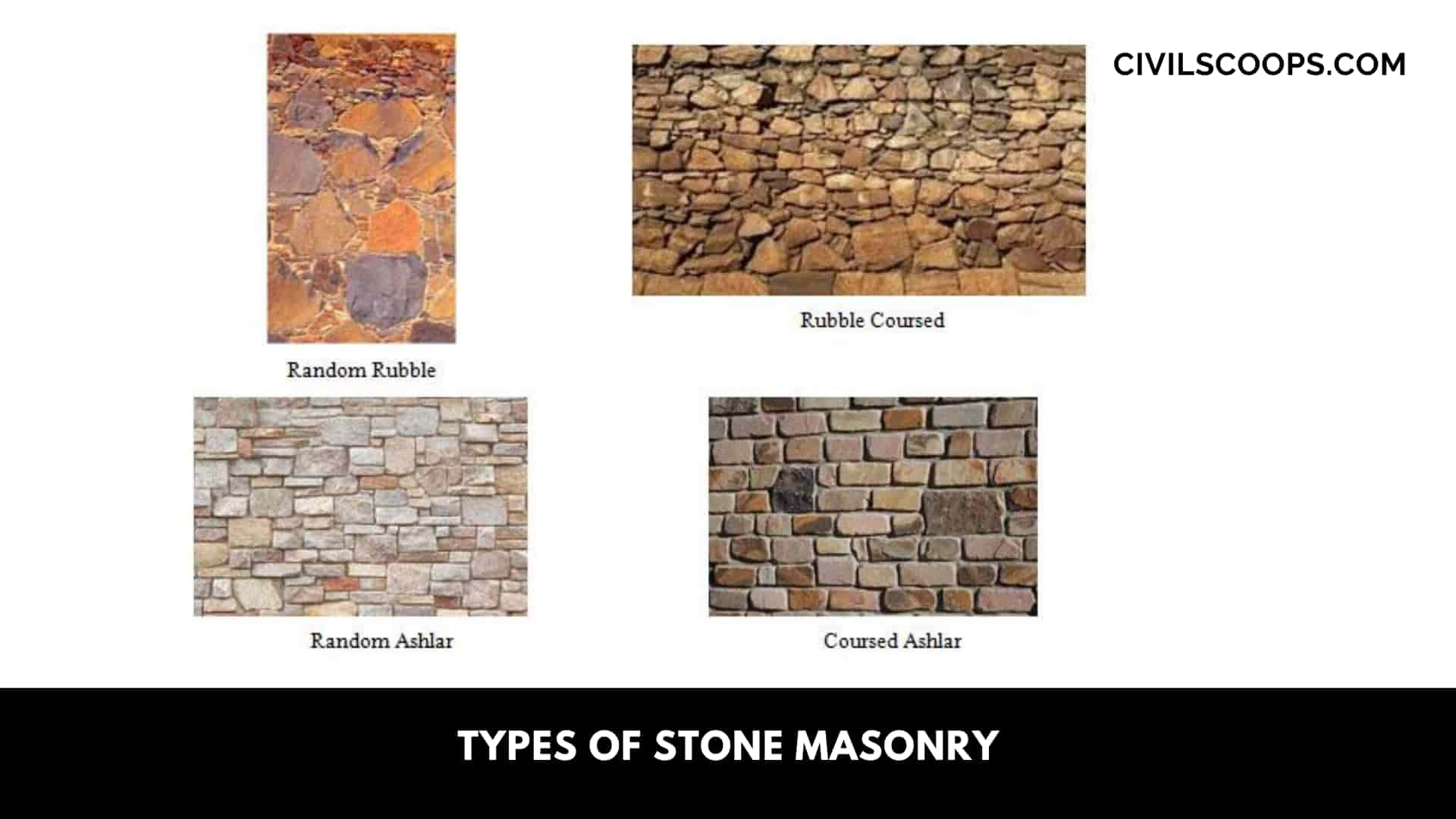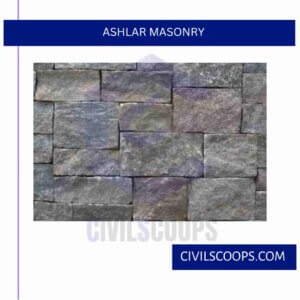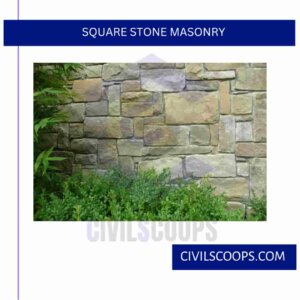What Is Stone Masonry | Types of Stone Masonry

Masonry means construction of buildings utilizing building blocks such as stone, bricks, and concrete blocks, etc.. Masonry is used for the construction of foundation, plinth, walls, and columns.
Mortar is the binding material for the building blocks. In this article, different kinds of stone masonry used are explained, and points to be observed while supervising stone masonry works are listed.
Table of Contents
What Is Stone Masonry?

The construction of stones bonded together with mortar is termed as stone masonry. Where the stones can be found in abundance in nature, on cutting and dressing to the proper shape, they provide an economical material for the construction of various building components such as walls, columns, tootings, arches, beams, etc.
Stone masonry being stronger, durable, and weather-resistant, when compared with brick masonry, is used in the construction of piers, docks, dams lighthouse, and other marine structures.
Also Read: Properties of Stones | Requirements of Good Building Stones
Types of Stone Masonry

Mainly there are three Stone Work Types:
- Rubble Masonry.
- Ashlar Masonry.
- Squared Stone Masonry.
1. Rubble Masonry.

Rubble, composed of natural stone, or stone so dressed as not to permit laying with uniformly thick joints or horizontal joints.
Rubble masonry may be laid coursed or uncoursed. When coursed, the stones are leveled off at specified heights to an approximately horizontal surface.
These courses are not necessarily of the same height but may rise by steps. This work is said to be random coursed.
In uncoursed rubble, the stones are fitted together without regard for courses. Dry rubble is laid without mortar, in low retaining walls and slope walls.
Most of the low retaining walls, slope walls, and miscellaneous structures in part projects are laid up in rubble masonry.
It fits into the surroundings better than more formal kinds of masonry and is usually built of stones found nearby.
For these projects, it is the most attractive masonry when well built, and satisfies all of the requirements of such field structures.
More than that, rubble masonry is a thing of beauty’ when well done, and its composition and. Pattern call for good Judgment and imagination.
One factor in doing a pleasing job Is the choice of stones for size. By observing the rule that headers must be used frequently to tie the wall together, considerable variation in size will be realized.
Smaller stones, chinking irregular spaces between larger stones, also add to the pattern.
The choice of stones for shape is another factor deserving many studies. Since it is unnecessary to hold to courses of uniform height, odd shapes can be used with fine effect.
Occasionally a stone of striking shape and considerable size can be placed to break up too much regularity in the pattern. Long, thin planes give a horizontal effect, which is most pleasing in low structures.
The mortar joints must be kept as uniform in thickness as possible. Many variations in the thickness of the joints will destroy whatever beauty the pattern may have in other respect.
Remember that the wall must be strong, as well as pleasing. So there is more than the pattern on the face to consider.
The pattern need not be sacrificed for strength if stones are chosen for their width extending through the wall, as well as for shape and size, and if care is taken to use a header at every opportunity.
Rubble masonry is one of the best things that an enrollee can learn to handle, for experts in this trade are in demand, and architects and landscape architects always have the need of men who can lay up this type of masonry in an artistic manner.
The thing we find most beautiful is that which satisfies our sense of proportion and of the suitability of materials, and our feeling for good taste in design.
It will be simple and appropriate, in a pattern pleasing in its variety and balance, end having unity, with its surroundings.
Also Read: Load-Bearing Vs Partition Walls | What Are Walls | Classified of Walls
2. Ashlar Masonry.

Ashlar is stone dressed to permit laying with uniformly thick horizontal joints l/2 inch thick or less. It is divided into two classes:
First, ranged or regular coursed ashlar, also called cut-stone work or dimensioned stone work. This is made of rectangular blocks cut and dressed to prescribed dimensions, and laid in courses of uniform height.
Second, broken ashlar, which is made of rectangular stones cut to dimensions, but not of equal thickness, and laid in the wall in courses which are not continuous throughout. The courses are not always of the same height.
Ashlar is the finest class of masonry. Extreme care is used in setting the stones. The bed for the stone must be thoroughly clean and wetted down.
A thin layer of mortar is then spread evenly. The bed surface of the stone is wetted down. Then the stone is lowered into place on two strips of wood laid in the mortar.
Heart, with a pinch bar, the stone is moved into its exact position and plumbed. The strips of wood are then removed, and the stone settled into place, being leveled by striking with a wooden mallet. The mortar joint should not be over l/2 inch thick.
Each of these three classes of stone masonry is divided into several others. These other classes and combinations of types of arc often used with distinctive names.
Also Read: What Is Sealing Brick Work| Advantages of Brick Sealer | Types of Brick Sealer
3. Square Stone Masonry.

Square Stone Masonry is laid up with a stone that has been roughly dressed to permit its laying with horizontal joints l/2 inch thick or thicker and is adapted to the same bonds as ashlar.
It is not dressed to as fine a finish as ashlar and therefore, may require joints thicker than 1/2 inch to take up the inequalities of the stones.
It is divided into three classes:
- Range masonry, in which all stones are of the same height, and their lengths are fairly uniform.
- Broken range, in which the courses are not all of the same height, and two stones are occasionally used to make up the height of the course. The length of the stones may vary a great deal.
- Random range, in which the height of courses, the height of stones to make up the courses, and the length of stones may all vary, making an irregular pattern not greatly different from broken ashlar.
[su_box title=”FAQ” style=”default” box_color=”#333333″ title_color=”#FFFFFF” radius=”3″ class=”” id=””]
Ashlar Masonry
Ashlar masonry is a type of stone construction where all stones are dressed or cut to a uniform shape, size, and surface appearance. They are then laid in horizontal courses, or layers, with very little of a supporting substance called mortar between them.
Rubble Masonry
rubble masonry, also called rubblework, the use of undressed, rough stone, generally in the construction of walls. Dry-stone random rubble walls, for which rough stones are piled up without mortar, are the most basic form.
Ashlar Rough Masonry
Ashlar masonry is a type of stone construction where all stones are dressed or cut to a uniform shape, size, and surface appearance. They are then laid in horizontal courses, or layers, with very little of a supporting substance called mortar between them. Ashlar masonry is a very old type of construction.
What Is Ashlar Stone Masonry?
Ashlar stone masonry is a type of stone construction technique that involves using precisely cut and dressed stones to create smooth, square, and rectangular blocks. These blocks are carefully arranged in horizontal courses to form a wall or structure. Ashlar masonry is known for its clean, uniform appearance, as the stones fit together tightly with minimal visible joints.
Types of Stone Masonry
- Ashlar fine tooled.
- Ashlar rough tooled.
- Ashlar rock faced.
- Ashlar chamfered.
Types of Rubble Masonry
- Random Rubble Masonry: Irregularly shaped stones with no systematic arrangement.
- Coursed Rubble Masonry: Roughly dressed stones in horizontal courses.
- Dry Stone Rubble Masonry: No mortar used, stones interlock for stability.
- Flint Rubble Masonry: Constructed using flint stones.
- Pitched Rubble Masonry: Stones have flat faces and pitched sides for stability.
Different Types of Stone Masonry
The two main classifications of Stone Masonry are: Rubble Masonry. Ashlar Masonry.
Ashlar Masonry Types
Ashlar Masonry and its Types
- Ashlar Rough Tooled Masonry.
- Ashlar Fine Tooled Masonry.
- Ashlar Facing.
- Coursed Ashlar Masonry.
- Chamfered Ashlar Masonry.
- Random Ashlar Masonry.
Brick Masonry and Stone Masonry
Bricks are more porous than stones hence we can say that stone work is more durable than brick work. Stonework is cheaper in the areas where stones are easily available (hilly areas). Stonework is much stronger than brickwork. Good quality architectural effects can be developed in stonework.
Stone and Brick Masonry
There are in general two types of masonry, viz., Brick Masonry and Stone masonry. Brick masonry is that in which bricks are used while in stone masonry, stone blocks are used. Comparison of Brick Masonry and Stone Masonry. Generally brick masonry is cheaper than stone masonry and can be easily constructed.
Types of Stones Used in Stone Masonry
- Granite: Durable and strong, used for heavy-load bearing structures and monuments.
- Limestone: Workable and aesthetically appealing, used for facades and decorative purposes.
- Sandstone: Easy to carve, available in various colors, commonly used in building construction.
- Marble: Elegant and beautiful, used for ornamental and decorative applications.
- Slate: Low water absorption, used for roofing, flooring, and cladding.
Stone Work Types
- Ashlar Masonry: Precisely cut stones in smooth, square blocks.
- Rubble Masonry: Rough, irregular stones in random patterns.
- Dry Stone Masonry: Stones without mortar for stability.
- Carving: Sculpting stones for decorative elements.
- Cladding: Stone veneers on building facades.
Rubble Stone Masonry
Rubble stone masonry is a type of stone construction in which rough, irregularly shaped stones of different sizes and materials are used. Unlike ashlar masonry, which involves precisely cut and dressed stones, rubble masonry uses stones in their natural form, with minimal shaping. The stones are typically selected from the local surroundings and arranged in a random or coursed pattern, depending on the desired appearance and structural requirements.
Coursed Ashlar Masonry
Coursed ashlar masonry is a type of stone construction that combines the precision and uniformity of ashlar masonry with a structured arrangement of stones in horizontal courses. In this method, the stones are carefully cut and dressed to have flat beds and sides, creating smooth, rectangular blocks with consistent heights and widths.
Rubble Stone Masonry Wall
A rubble stone masonry wall is a type of construction where rough, irregularly shaped stones are used to build a wall. The stones are typically sourced from the local environment and are not precisely cut or dressed. Instead, they are placed in a random or coursed pattern, depending on the intended appearance and structural requirements.
Stone Masonry Price Per Square Foot
On average, building a stone wall costs between $20 and $50 per square foot. Combining rock walls with: Natural stone costs $30 to $50 or more per square foot. Stone veneer costs $15 to $30 per square foot.
Coursed Rubble Masonry
Coursed rubble stone masonry is made with broken stones of widely different sizes and qualities that are laid in level courses. One of the most common forms of masonry construction, coursed rubble stones are typically hammer dressed to be shaped into more controlled and equal sizes.
Random Rubble Stone
Random rubble
It is the roughest and the cheapest form of stonewalling. Since stones are not of uniform shape and size, they are arranged with great care so as to distribute pressure over the maximum area and at the same time avoid long vertical joints.
[/su_box]
[su_note note_color=”#F2F2F2 ” text_color=”#333333″ radius=”3″ class=”” id=””]
Like this post? Share it with your friends!
Suggested Read –
- Concrete Construction Tools for Construction Sites
- All About Marble Flooring | What Is Marble Flooring | Types of Marble Flooring
- What Is Roof Replacement | What Is Roof Repair | Difference Between Roofing Repair and Replacement
- What Does Hail Damage Look Like on a Roof | Identifying Hail Damage to Your Roof | Wood Shingles Hail Damage
- What Is Asphalt Paving | Types of Asphalt Paving | What Does Asphalt Cost | Hot Mix, Warm Mix, and Cold Mix Asphalt
[/su_note]
Originally posted 2023-08-04 11:31:02.
